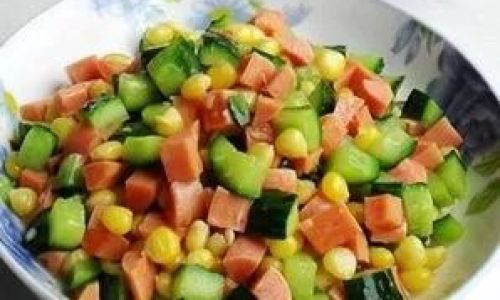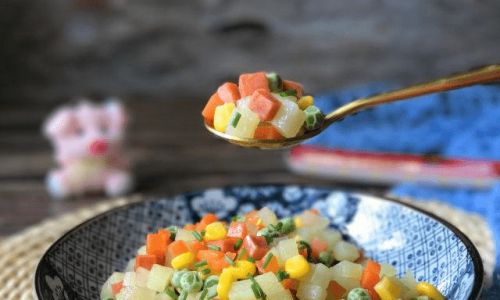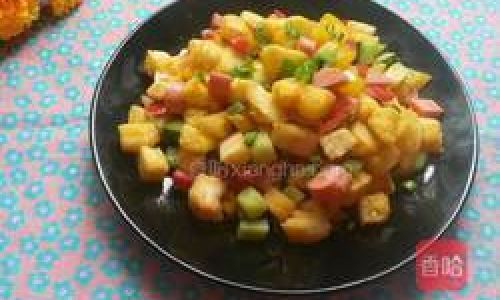Introduction
In the realm of home cooking, few dishes rival the charm of a vibrant, nutrient-packed meal that tantalizes both the eyes and the palate. Colorful vegetable and ham cubes, often referred to as “彩蔬火腿丁” in Chinese cuisine, exemplify this harmony. Bursting with fresh flavors, textures, and a kaleidoscope of hues, this dish transforms simple ingredients into a culinary masterpiece. Whether you’re a seasoned chef or a novice in the kitchen, mastering this recipe promises a rewarding experience. This article delves into the intricacies of creating this dish, from selecting the finest ingredients to perfecting the cooking technique. By the end, you’ll be equipped to serve a meal that’s as visually stunning as it is delicious.
The Allure of Colorful Vegetable and Ham Cubes
The beauty of this dish lies in its simplicity and versatility. It combines the smoky richness of ham with the crisp freshness of seasonal vegetables, creating a balance of flavors that appeals to all ages. The vibrant colors—emerald green peas, ruby-red bell peppers, golden carrots—not only elevate the dish’s aesthetic appeal but also hint at its nutritional value. Each bite offers a medley of vitamins, minerals, and protein, making it a wholesome choice for lunches, dinners, or even meal prep.
Ingredients: A Symphony of Freshness
To craft the perfect colorful vegetable and ham cubes, start by gathering high-quality ingredients. The key is to prioritize freshness and variety. Here’s a breakdown of what you’ll need:
-
Vegetables:

- Bell Peppers (Red, Yellow, and Green): These add sweetness, crunch, and a rainbow of colors.
- Carrots: For a subtle earthy sweetness and vibrant orange hue.
- Peas: Fresh or frozen, they contribute a pop of green and delicate sweetness.
- Corn Kernels: Sweet and juicy, they balance the dish’s texture.
- Onion: Aromatic and pungent, it forms the flavor base.
- Garlic: For a hint of sharp, savory depth.
- Optional Additions: Zucchini, mushrooms, or cherry tomatoes for extra layers of flavor.
-
Ham:
Opt for high-quality cooked ham, such as Black Forest or honey-roasted varieties. Avoid overly salty options, as they may overpower the vegetables.
-
Seasonings and Oils:
- Olive Oil: For sautéing the vegetables.
- Soy Sauce (or Tamari for gluten-free): A dash adds umami richness.
- Black Pepper: Freshly ground for a spicy kick.
- Paprika or Chili Flakes: For a hint of heat (optional).
- Herbs: Fresh parsley or cilantro for garnish.
Equipment: Tools of the Trade
Before diving into cooking, ensure your kitchen is equipped with the following:
- Large Skillet or Wok: Essential for even heat distribution and stir-frying.
- Cutting Board and Sharp Knife: Precision is key for uniformly diced ingredients.
- Mixing Bowls: To prep and stage ingredients before cooking.
- Spatula or Tongs: For gentle stirring without bruising the vegetables.
- Measuring Spoons: To control seasoning amounts.
Step-by-Step Preparation
Mise en Place: The Art of Preparation
French for “putting in place,” this culinary principle emphasizes organizing ingredients before cooking. Dice the ham into ½-inch cubes. Chop the bell peppers, carrots, and onions into similar-sized pieces to ensure even cooking. Mince the garlic finely. If using fresh peas, shell them; if frozen, thaw slightly. This upfront effort streamlines the cooking process and prevents scrambling mid-recipe.
Sautéing Aromatics
Heat a tablespoon of olive oil in the skillet over medium heat. Add the diced onions and sauté until translucent (3-4 minutes). Stir in the minced garlic, cooking for another minute until fragrant. Avoid browning the garlic, as it can turn bitter.
Cooking the Vegetables in Stages
Vegetables cook at different rates, so add them in stages to preserve texture and color:
- First Layer: Toss in the carrots. Sauté for 3-4 minutes until slightly tender.
- Second Layer: Add the bell peppers. Stir-fry for 2-3 minutes, maintaining their crispness.
- Third Layer: Incorporate the peas and corn. Cook for 1-2 minutes until warmed through.
Introducing the Ham
Add the diced ham to the skillet, stirring gently to combine. The ham’s salty, smoky flavor will meld with the vegetables, creating a harmonious taste profile. Cook for 2-3 minutes until heated.

Seasoning Mastery
Sprinkle the dish with a pinch of salt, black pepper, and paprika. Drizzle a teaspoon of soy sauce for depth. Toss lightly to coat evenly. Taste and adjust seasonings as needed—remember, it’s easier to add than to fix over-seasoning.
Final Flourish
Remove the skillet from heat. Garnish with fresh herbs like parsley or cilantro. For a zesty twist, squeeze a wedge of lemon over the dish before serving.
Tips for Perfecting the Dish
- Uniformity in Dicing: Ensure all vegetables and ham are cut to the same size for even cooking and a polished presentation.
- Avoid Overcrowding the Pan: Cook in batches if necessary to prevent steaming, which can lead to soggy vegetables.
- Freshness First: Use the freshest vegetables possible, as frozen alternatives may release excess moisture.
- Customize the Heat: Adjust chili flakes or paprika to suit your spice tolerance.
- Protein Swap: Vegetarian? Substitute ham with diced tofu or tempeh for a plant-based twist.
Serving Suggestions
- As a Standalone Meal: Pair with steamed rice, quinoa, or cauliflower rice for a complete plate.
- Wrap It Up: Spoon the mixture into whole-grain tortillas for colorful tacos.
- Salad Topper: Use cold leftovers to adorn leafy greens with a protein-packed punch.
- Breakfast Boost: Reheat and serve alongside a fried egg for a hearty morning meal.
Variations and Substitutions
The beauty of this recipe is its adaptability. Here are creative tweaks to keep things interesting:
- Mediterranean Twist: Add diced cucumbers, olives, and feta cheese. Drizzle with balsamic glaze.
- Asian Fusion: Incorporate snap peas, water chestnuts, and a splash of sesame oil. Garnish with sesame seeds.
- Spicy Kick: Introduce jalapeños or serrano peppers during the sauté phase.
- Cheese Lover’s Delight: Sprinkle shredded cheddar or Parmesan over the finished dish.
Storage and Reheating
Leftovers can be stored in an airtight container in the refrigerator for up to 3 days. To reheat, use a skillet over medium heat to retain crispness, or microwave in short bursts. Avoid freezing, as vegetables may become mushy upon thawing.
Nutritional Benefits

This dish is a nutritional powerhouse:
- Vegetables: Rich in vitamins A, C, and K, fiber, and antioxidants.
- Ham: Provides protein and essential minerals like iron and zinc.
- Low in Calories: A light yet satisfying option for weight-conscious diets.
Common Pitfalls and How to Avoid Them
- Mushy Vegetables: Overcooking is the culprit. Test doneness by piercing with a fork—vegetables should be tender-crisp.
- Bland Flavor: Over-reliance on salt can mask natural tastes. Enhance with herbs, citrus, or a splash of vinegar instead.
- Uneven Cooking: Inconsistent dice sizes lead to uneven cooking. Invest in a sharp knife and practice your knife skills.
The Final Bite: A Culinary Triumph
Colorful vegetable and ham cubes are more than a meal—they’re a celebration of culinary creativity. By mastering this recipe, you gain a versatile dish that adapts to seasons, diets, and occasions. Whether served at a family dinner, a potluck, or a solo weeknight feast, its vibrant hues and balanced flavors will leave a lasting impression. So, grab your apron, sharpen your knife, and embark on a journey to transform simple ingredients into a symphony of taste and color. Your taste buds—and your Instagram followers—will thank you.
Conclusion
In a world where convenience often trumps creativity, dishes like colorful vegetable and ham cubes remind us of the joy of home cooking. They bridge the gap between nutrition and indulgence, proving that healthy food need not be boring. With practice, you’ll refine your technique, experiment with flavors, and perhaps even inspire others to embrace the art of vibrant, wholesome meals. So, the next time you’re at the grocery store, fill your basket with an array of colorful produce and a slab of quality ham. The result? A dish that’s as delightful to behold as it is to devour. Happy cooking!






0 comments